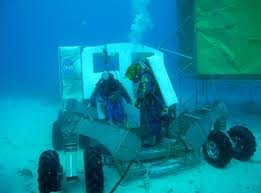 In an effort to learn as much as possible about operating a crew in extreme environments, with hope of using that information in a potential mission to an asteroid, NASA has sent an international crew of aquanauts (astronauts, engineers and scientists) to a new home on the Atlantic Ocean floor.
In an effort to learn as much as possible about operating a crew in extreme environments, with hope of using that information in a potential mission to an asteroid, NASA has sent an international crew of aquanauts (astronauts, engineers and scientists) to a new home on the Atlantic Ocean floor.
This latest group will spend 12 days testing concepts in what is the 16th excursion of the NASA Extreme Environment Mission Operations (NEEMO). The mission takes place in an underwater research habitat 63 feet down in the Atlantic located near Key Largo Florida. The habitat is operated by the National Oceanic and Atmospheric Administration and it dubbed the Aquarius Reef Base. On Monday of last week, the 4 person crew entered the Aquarius just after 11am eastern.
Using the NEEMO 16 environment challenges the crew will learn to contend with issues similar to those which could be faced in an isolated extreme environment in space. Specifically this mission will focus on communication delays, restraint and translation techniques, and optimum crew size.
As part of NASA’s new direction toward human exploration of deep space using the Orion spacecraft and the Space Launch System rocket currently under development, the first mission sending a human team to an asteroid is planned for 2025.
The crew of the NEEMO 16 mission consists of Commander Dottie Metcalf-Lindenburger of NASA, astronaut Timothy Peake from the European Space Agency, Japan Aerospace Exploration Agency astronaut Kimiya Yui, and Steven W. Squyres, Goldwin Smith professor of astronomy at Cornell University and chairman of the NASA Advisory Council.
Much of the actions and progress of the NEEMO crew members, including helmet cams and other habitat cameras, will be carried over live streaming video and other data published online through a variety of social media outlets. More information about the NEEMO missions including connecting to the coverage is available online at: http://www.nasa.gov/neemo.
![Herbal Reference Substances are Key to Everyday Products <!-- AddThis Sharing Buttons above -->
<div class="addthis_toolbox addthis_default_style " addthis:url='http://newstaar.com/herbal-reference-substances-are-key-to-everyday-products/3512112/' >
<a class="addthis_button_facebook_like" fb:like:layout="button_count"></a>
<a class="addthis_button_tweet"></a>
<a class="addthis_button_pinterest_pinit"></a>
<a class="addthis_counter addthis_pill_style"></a>
</div>When it comes to quality control testing and the development of new products, Botanical Reference Materials (BRMs), also known as Herbal References are critically important. To help companies ultimately obtain all-important FDA approval, the Food and Drug Administration provides in its guidance a recommendation that […]<!-- AddThis Sharing Buttons below -->
<div class="addthis_toolbox addthis_default_style addthis_32x32_style" addthis:url='http://newstaar.com/herbal-reference-substances-are-key-to-everyday-products/3512112/' >
<a class="addthis_button_preferred_1"></a>
<a class="addthis_button_preferred_2"></a>
<a class="addthis_button_preferred_3"></a>
<a class="addthis_button_preferred_4"></a>
<a class="addthis_button_compact"></a>
<a class="addthis_counter addthis_bubble_style"></a>
</div>](http://newstaar.com/wp-content/uploads/2021/02/Achillea_millefolium_flowers-100x100.jpg)
![Quality Electrochemical Biosensors are Critical for Medical, Food and Chemical Industry <!-- AddThis Sharing Buttons above -->
<div class="addthis_toolbox addthis_default_style " addthis:url='http://newstaar.com/quality-electrochemical-biosensors-are-critical-for-medical-food-and-chemical-industry/3512086/' >
<a class="addthis_button_facebook_like" fb:like:layout="button_count"></a>
<a class="addthis_button_tweet"></a>
<a class="addthis_button_pinterest_pinit"></a>
<a class="addthis_counter addthis_pill_style"></a>
</div>A number of industries have, at their core, a need to frequent or even continuous analysis of biological media. These include the medical and pharmaceutical fields, biotech firms, and food and chemical companies. To maintain quality standards and develop new products, these industries rely heavily […]<!-- AddThis Sharing Buttons below -->
<div class="addthis_toolbox addthis_default_style addthis_32x32_style" addthis:url='http://newstaar.com/quality-electrochemical-biosensors-are-critical-for-medical-food-and-chemical-industry/3512086/' >
<a class="addthis_button_preferred_1"></a>
<a class="addthis_button_preferred_2"></a>
<a class="addthis_button_preferred_3"></a>
<a class="addthis_button_preferred_4"></a>
<a class="addthis_button_compact"></a>
<a class="addthis_counter addthis_bubble_style"></a>
</div>](http://newstaar.com/wp-content/uploads/2020/10/Electrochemical-Biosensor-100x100.jpg)
![Company Develops Industrial Mixers Well-Suited for both Fragile and Explosive Products <!-- AddThis Sharing Buttons above -->
<div class="addthis_toolbox addthis_default_style " addthis:url='http://newstaar.com/company-develops-industrial-mixers-well-suited-for-both-fragile-and-explosive-products/3512071/' >
<a class="addthis_button_facebook_like" fb:like:layout="button_count"></a>
<a class="addthis_button_tweet"></a>
<a class="addthis_button_pinterest_pinit"></a>
<a class="addthis_counter addthis_pill_style"></a>
</div>Industrial drum mixers are normally applied to blend mixes of varying viscosities such as adhesive slurries or cement. Some of these mixers have the capability of blending mixes of very different particle sizes such as fruit and ice cream, and gravel and cement slurry. The […]<!-- AddThis Sharing Buttons below -->
<div class="addthis_toolbox addthis_default_style addthis_32x32_style" addthis:url='http://newstaar.com/company-develops-industrial-mixers-well-suited-for-both-fragile-and-explosive-products/3512071/' >
<a class="addthis_button_preferred_1"></a>
<a class="addthis_button_preferred_2"></a>
<a class="addthis_button_preferred_3"></a>
<a class="addthis_button_preferred_4"></a>
<a class="addthis_button_compact"></a>
<a class="addthis_counter addthis_bubble_style"></a>
</div>](http://newstaar.com/wp-content/uploads/2020/06/bandeau-sofragir2-100x100.jpg)